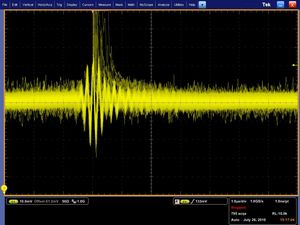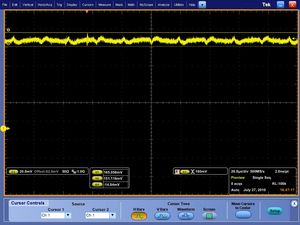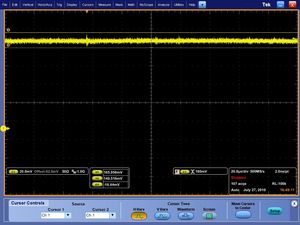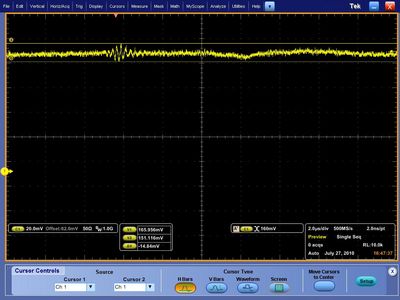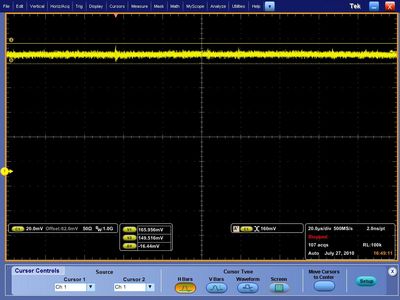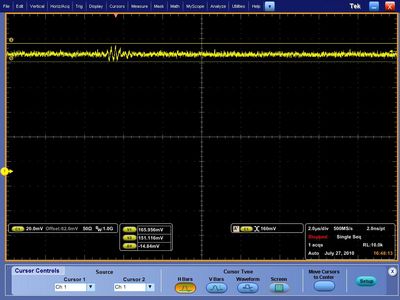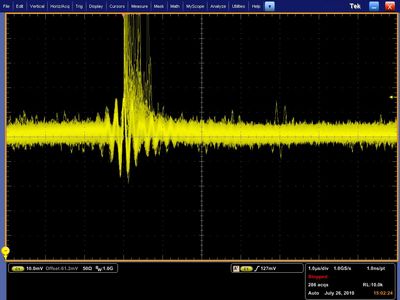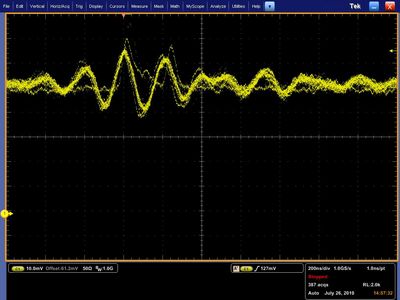Noise studies
After attaching the thermocouples to the small CDC prototype we observed that the post-shaper pedestal width was largest in the straws nearest the top of the prototype - it showed a steady increase moving up the detector whereas previously the widths had all been similar. At this point it went from approx 11ch (lowest row of straws) to 18 ch (highest row) (run 30765, 13 June 2010, ADC range ~ 550mV). The thermocouple wires were attached to the gas plenums at the top. After moving the thermocouple wires around and observing the signals on the oscilloscope we realised that the thermocouple wires were picking up e-m noise and passing this on to the nearest straws.
scope traces for straw 16, which shows the largest amount of 4MHz pickup. The left hand side plots also show some cosmics.
This pickup was hardly noticeable in the lowest row of straws (xx cm below the top row).
As well as picking up ambient e-m noise (mostly 4-5Mhz) the thermocouple control unit also contributed some noise of its own (20Mhz). When taking Fe55 data the ADCs are triggered on signals in straw 15 and this internal threshold was increased from xxx to xxx in order to eliminate the noise-only events.
We moved the detector into a small mesh box to act as a Faraday cage which decreased the pedestal sigma to 9-11 channels, for all straws. At this point we discovered that connecting the HV ground to the shielding covering the preamp-shaper signal cable reduced the pickup by 50% but grounding the cage separately increased the pickup dramatically (more details follow later).
Some oscillation in the post-shaper signal originates from the Vern-Kiebler HV supply. [[1]] This is also visible in the low-voltage test output from the front of the unit as a 27kHz square wave +/- few mV.
We switched to a Bertan 215 HV supply which cut the pedestal sigma down to 5 to 7 channels... but also decreased the tracking efficiency by 50%.
So we returned to the Vern_Kiebler unit.
The LV supply is a HP6216, the + and - leads go to the preamp; the ground was not used. Pickup was reduced slightly when we moved the LV supply unit inside the cage (its output wires were unshielded) but the trailing cables were undesirable and so we returned it to the DAQ rack and added shielding braid outside the cables. This braid was grounded to the LV ground, but making this connection made no observable difference to the pickup. Moving the LV back to the rack added 1mV to the pickup.
The SHV cable was connected to the thin wires which then connected to the detector's HV board. We added shielding braid to cover these and connected it to the HV ground at the end of the SHV cable. Linking this shielding braid to the LV shielding braid close to the cage decreased the pickup noise to xx and linking it to the cage as well decreased it further. At this point no further reduction was obtained by linking the preamp-shaper cable shield to the HV ground :-)
old scope traces below
HV on (HV ground & cable shielding connected) The envelope oscillates at about 27kHz.
HV off (HV ground & cable shielding connected)
After connecting the HV ground to the preamp end of the cable shielding
The traces below also show ch16 at a much smaller timescale, 20 μs/div, with the HV supply to the CDC prototype on and off.
